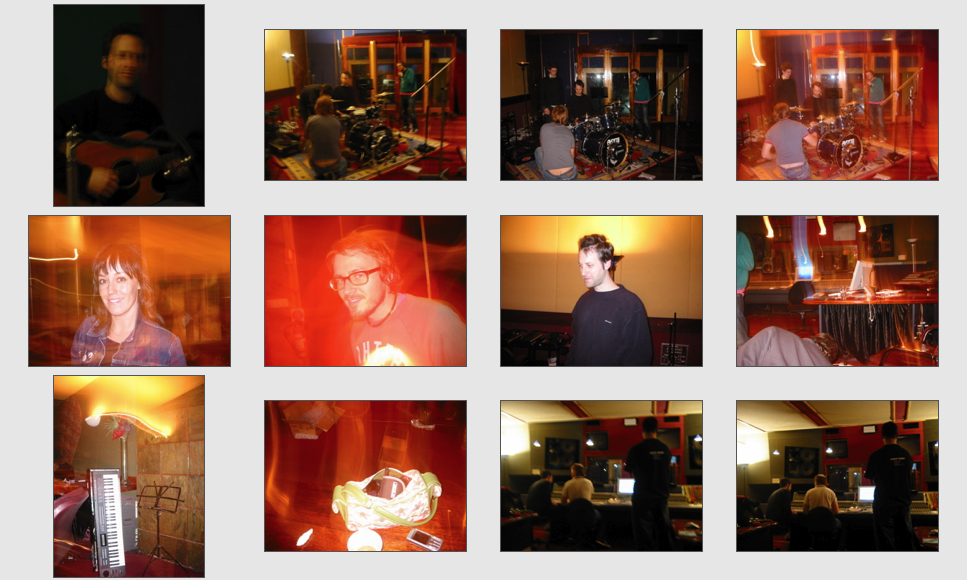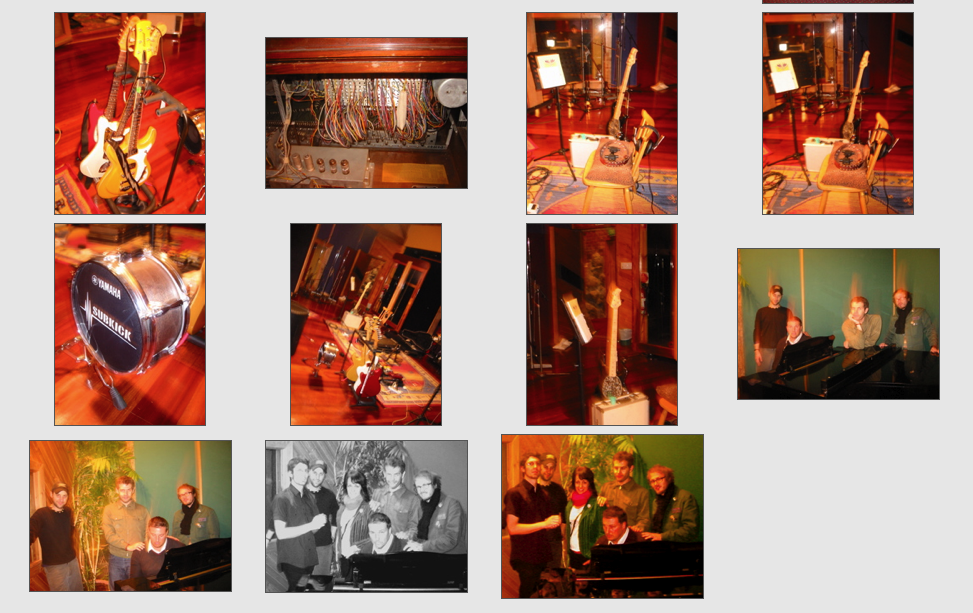
Interview by Matthew Levinson
Mist and Sea, the pairing of Underground Lovers veteran Vincent Giarruso and Pretty Boy Crossover pair Jason Sweeney and Cailan Burns, along with bassist (and sound designer) Emma Bortignon, guitarist Jed Palmer and Phil Collings, seems such a good fit it’s hard to believe it took so long to happen.
The Underground Lovers hung on a long time. Long after the flash of success, after the band left its prickly major label deal, even after they seemed to have lost the passion for each other, the band kept dropping records on their own Mainstream Records label.
It’s no wonder; hanging onto a melody like a hand reaching down from above a gaping crevasse, the Underground Lovers were never afraid to put everything on the line for their songs. Each one seemed breathlessly intimate, building layer upon layer of sound until they were ripe to spill.
Their second album Leaves Me Blind is still spellbinding. At the time of its release, 15 years ago, the Underground Lovers was the hottest band in Melbourne, if not the world. They won the 1992 Best New Artist ARIA, and when released in the UK, on 4AD imprint Guernica, Melody Maker called Leaves Me Blind a contender for album of the year.
Mood, atmosphere and sound coalesced into hypnotic songs that bridged the gap between late “90s “shoegazer’ bands like My Bloody Valentine and Ride, and Manchester’ New Order. Truth be told, their defining musical influences were more likely to be found further afield and closer to home: Can, Galaxie 500, the Go Betweens and Essendon Airport.
“Before forming Underground Lovers, I remember seeing Essendon Airport at Melbourne Uni and being blown away by their drummer, who was wild, and a picture of poetic chaos in motion,†says Vince Giarruso, former singer with the Underground Lovers.
“But I always thought their guitar styling was more funk-driven, hence their progression to I’m Talking [which launched pop chanteuse Kate Ceberano’ career]. So I never really got the influence… except they were cool indie uni types, and we were trying hard as all hell to be that.â€
“The catalyst [for our music]was complex; a mix of looking at the past, and then what was going on at the time around us, and then projecting into the future. So there was always this sense of progression in the work. And always this notion of structuring sound, songs and lyrics, so that if you wanted, you could listen to an Undies record and be taken from one place to another. I know for me it was always about writing and structure and how to put together a set of ideas and songs into a structure that was coherent and atmospheric. Cinema and the feelings evoked by the experience of cinema is obviously a big part of that – still is – as was the indie music scene at the time, especially English stuff like Primal Scream, My Bloody Valentine and the Happy Mondays.â€
Giarruso and guitarist Glenn Bennie met in high school and bonded over music and drama classes at university. Hence the band’ moniker, taken from the Italian surrealist play of the same name. Their first record, a 7†single as Blast, came out in 1988, but within two years the band had changed names and played their first show, at the Corner Hotel, Melbourne. Although they quickly signed on with up and coming manager Craig Kamber, the band had paid to record and release the Nice EP and a self-titled debut album.
Reality, for want of a better word, played a big part in the band’ story. With their epochal second album due to hit shelves, Kamber, who went on to double as the band’ A&R man at the RooArt label (read Craig Mathieson’ The Sell In for the story), shopped the band to the majors behind their backs.
“I guess the behaviour and choices made back then were pretty much stock standard in a “professional’ set up. It happens to a lot of bands. It’s what happens when business meets creativity. I’ve been reading Adorno’ The Culture Industry, which, besides being hilarious, is also very insightful in regards to getting a handle on the corporate handling of art, artists and “culture’.â€
“It was weird “cause I remember we just got on with doing what we loved doing, which was touring and making records. We never really got into the media buzz stuff “cause… well it’s kinda embarrassing and stupid really. I had two daughters under the age of two when all that happened, so I had to balance home life with it. All the legal hassles we had and then being sued for lots of money when you are struggling on the dole with two young children was pretty shitful, but we got through.â€
Until then, Giarruso also had a “full-on†day job as a social worker with under-privileged and abused teenagers – “The experiences from that time are always with me,†he says – it provided the inspiration for his first film, Mallboy.
“I guess working in that environment gives you insight into the lowest places human interaction can take you, but then it was tempered by the enormous potential and joy of being a teenager. It was an uneasy job to have and I wasn’ very good at it. Having said that, and with the knowledge of hindsight, I can say there are similarities between the social service industry and the film/music industries – both industries have a tendency to reduce people to client/consumers with a total disregard and misunderstanding of process and outcome.â€
Dream It Down, produced by David Chesworth and Robert Goodge (Essendon Airport), was produced around the same time. It spawned the Triple J favourite “Losin’ It,’ along with a clear, warmer sound that replaced its predecessor’ alienated detachment with a lethargic, world-weariness that although superficially similar, reflected a world of change.
“Part of me really wishes I had got out around 1994 after Dream It Down, but I lacked confidence, and I had to see a few things through, which culminated in making Mallboy in 2000. Things just kinda happened so fast and you kinda don’ know what to make of it until later…â€
“Industry is what industry is. It’s there to make profits for the shareholders. So as an artist not to be cautious of the industry is kinda naive and dangerous. I love being “indie’ in the truest sense of the word, beholden to no-one or trends… but it’s kinda living in a bubble too, which has its own pitfalls. But you know the few times I did industry stuff, like awards nights and festivals, it was kinda fun and funny. If you’re a keen observer of human behaviour at its most vacuous and strangely complex, then they are the places to be.â€
The band swapped their Polygram deal for self-sufficiency; releasing a string of increasingly electronic-sounding records through their Mainstream label (via lawyer David Vodicka’ Rubber Records), before eventually splitting. Glenn Bennie stripped down to an acronym, GB3, and went on to collaborate with Steve Kilbey, Angie Hart and the late Grant McLennan. Vocalist Phillipa Nihill recorded several solo releases and has recently reappeared with Irish-influenced ambient duo Saoi. Giarruso made films and books, and is now studying and teaching at Swinburne University.

Three years ago, Giarruso met Jason Sweeney. Along with Sweeney’ Pretty Boy Crossover counterpart Cailan Burns and a handful of others, they began making music. Although they were all in Melbourne when the band got together, a quick diaspora left Burns in Osaka, Sweeney in Adelaide, Giarruso overseas for a spell and then in Sydney, and other members in Melbourne. Understandably, the recording and mixing process was long and convoluted.
“We had been getting together writing bits and pieces since 2004. I think we got the grant in 2004. I was in Sydney and Jason texted to say we got it. I forgot we had even applied. We recorded and mixed the bulk of the album in June 2005 and did the final mix and compilation around October 2006.â€
In an interview with AMO.org.au around the time the band got together, Burns and Sweeney were asked which Australian performer they would most like to work with.
“Funnily enough,†said Sweeney, “we’re starting to work with the very person we’ve been wanting to do stuff with for a long time: Vincent Giarrusso. Both us are big Underground Lovers fans. So there’ always been discussion around the Pretty Boy Crossover studios about collaborating or making music with him. And now the sonic wheels are almost in motion. It helped that both of us moved to Melbourne and that the meeting of Sweeney and Giarrusso happened almost within months… that now there is a possibility of something tangible on the way, if only conceptually for now.â€
In the same interview, Sweeney nominated Leaves Me Blind as his “most-played’ Australian release: “One of those records that seems to creep into the speakers at just the right moments. [It’] probably the unifying record that aligns both of our sonic palettes. A kind of seamless soundtrack to post-adolescent days.â€
“I was a very early fan of the Undies right back to their first 7†in 1990,†Sweeney says now. “And “cause their first LP had a very lo-fi sound, the surprise and delight of the expansive, cinematic and rather epic sound of Leaves Me Blind was like a revelation – Cailan and I hadn’ met when that record came out, so we were probably both hanging out in our bedrooms in different parts of the state just getting blissfully into it – and I wasn’ even on drugs.â€
Giarruso says the dreaminess helped him “articulate some complex emotions and situations.†But there was a dark, edgy undercurrent to the dreaminess – an alienation or detachedness that contrasted, and rather than undermining, actually heightened the beauty of the songs.
Its richness was reflected in Pretty Boy Crossover’ music; despite the differences – Pretty Boy’ is more abstracted, whereas the Lovers had pop hooks and real songs – the real thrust seemed to be in “movements,’ brooding across songs, across albums. But for all the focus on the pairing, all concerned are keen to point out the band is broader than just Giarruso, Sweeney and Burns.
“It also involved the amazing talents of Emma Bortignon, Jed Palmer and Phil Collings,†says Sweeney, “so it was a six person collaboration. The record was written in rehearsals and everybody contributed ideas. So this first album is very much a band project – which I ended up remixing to make it sound the way it ended up… and I really went to town on getting a hazier, dreamier sound. Believe me, we never intended to go so much down the rock band path – it just happened without anyone knowing really – and the following records will be different again.â€
“To be honest, the process of recording was very unusual for me,†he says. “Both of us are very much passionately interested in home or self-made studio recordings. And for this Mist and Sea record we went into the massive confines of the Sing Sing studios in Melbourne with a very limited time to record an entire LP. Mind you, we also had a little more luxury by doing overdubs at Chris Scallan’ fantastic Soft Centre studios too.â€
“So, we had all of these great “sounding’ recordings of the instruments,†Sweeney explains, “but the significant moments for me were then taking all of the recordings and reworking them in my own studio, Panoptiqué Electrical. Because I then had no constraints of time or money – I got to experiment and complete the picture on a pair of headphones. I think of what I did with the sounds as “de-slicking’ them! Ironically, getting a more bedroom recording quality to some very high-quality sounds.â€
That combination of production, musicianship and great songs sets Mist and Sea apart from the various projects of each band member. Giarruso’ songs clearly distinguish the project from Sweeney’ other indie/electro groups (Simpatico and Other People’ Children).
“”Like a Vampire’ and “Gestapo’ are songs that push buttons for me,†says Giarruso, “because structurally they are very different. The words are some of the first lyrics I wrote post-Undies and they fulfil my criteria for song lyrics in that they are ironic, funny – I think anyhow – deeply personal and tell small stories all at the same time. The album as a whole is very different structurally, which I think is exciting… it’s kinda broken into four sections, like four mini EPs, which resolve within themselves and as a whole.â€
“Golden,†says Sweeney, “is probably the “special’ track for me. It just has that expansive feel I love in pop music. But the whole album I treat as a complete thing and try to listen to it that way, rather than skipping or isolating songs. And at a precise 35 minutes, it is an album that is suitable for busy people!â€
“Cailan and I have always been drawn to the minor chord end of music making and enjoy immersing ourselves in all things melancholy,†he says. “I actually find this Mist and Sea record a very “up’ record in many ways, which is something I thought I’d never be part of. So, when it came to me doing the final mixes, I was really working towards drawing out the emotional content of the songs, trying to create a sort of journey for the listener. I always loved that about the way Underground Lovers released recordings – they were always very filmic and like soundtracks in themselves. It never surprised me that Vince went on to make films.â€

The name Pretty Boy Crossover was taken from a Pat Cadigan short story: “I’ve always loved it because, in a very straight male oriented music industry, I like to challenge the blokes a bit. [It’] funny because a lot of guys I know often resist saying the full name and end up just using the “PBXO’ tag.â€
Getting a band name from a book is just another parallel between the collaborators. Add that to prolific, borderline promiscuous collaboration, and an interest in artistic creation that traverses techniques and artistic endeavours and you have the makings of a fascinating long-term meeting of minds.
“I’m a generally nervous and anxious person, so I get pent up even meeting with people I know very well,†says Sweeney. “So when I met Vince for the first time it was definitely just like meeting anyone else I didn’ know – sorry Vince! – but I must add that we’d also had lots of email contact before that, so we weren’ complete strangers. To be honest, I just really had an intuition that maybe Vince and I could work on something together. We both seem to have a similar sense of dry nonsensical humour, so that helps a lot. Like with most things I do, there was never a grand strategy. Mind you, there were/are some fairly big ideas floating around.â€
Mist and Sea’s Unless is out soon on Popfrenzy.



